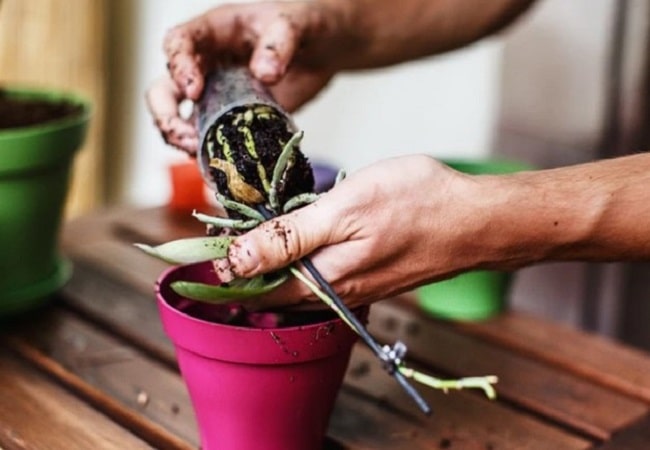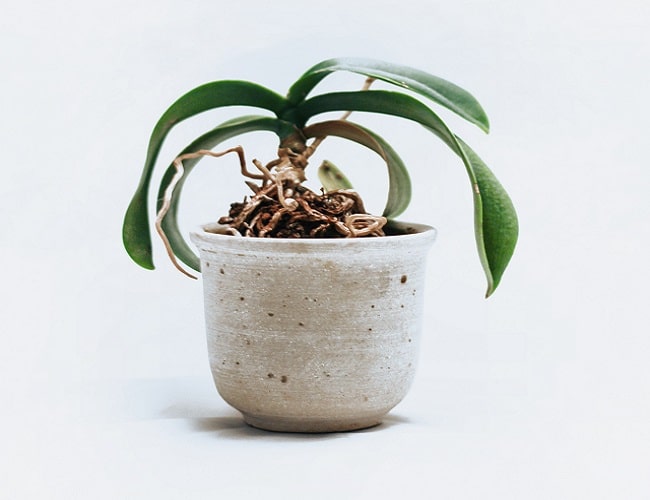Cymbidiums are a type of orchid distinguished by their large, showy blossoms that last for an extended period. These plants are from Asia and are often grown in warm climates as houseplants or in gardens outside. Like any other plant, cymbidium orchid dead bulbs can have problems, such as dying bulbs, which are also called dead pseudobulbs.
Many orchids, like cymbidiums, have thickened, swollen stems called pseudobulbs. These structures help the plant stay alive during drought or other stress by storing water and nutrients. When a pseudobulb dies because it doesn’t hold enough water, it gets sick, or pests eat it.
If you see that a pseudobulb on your cymbidium orchid has died, you need to figure out why and take the proper steps. In some cases, the pseudobulb may be too old to support the plant’s growth. In other cases, there may be a bigger problem that needs to be fixed to keep the plant from getting worse. Your cymbidium orchid will stay healthy and grow well if you give it the right amount of water and light and take care of its pseudobulbs.
Quick Navigation
Most Common Causes OF Cymbidium Orchid Dead Bulbs

Dead bulbs, or pseudobulbs, are frequently caused by several factors in Cymbidium orchids. Among the most frequent causes are:
- Overwatering And Underwatering: cymbidium orchid dead bulbs pseudobulb death is often caused by overwatering. Overwatering these plants might cause root rot and other issues. Cymbidium orchids may also suffer from insufficient watering.
- Poor Drainage: If the potting mix doesn’t drain well, the roots of the orchid can get waterlogged, which can cause root rot and eventually kill the bulbs.
- Lack of Sunlight: Cymbidium orchids need bright, indirect light, not direct sunlight, to grow well. If there isn’t enough light, the bulbs might burn out.
- Pest Infestations: Aphids, mealybugs, and thrips can eat the leaves and stems of orchids, which can hurt the plant and possibly kill the bulbs.
- Poor Quality Potting Mix: If you use a potting mix that doesn’t drain well or isn’t suitable for orchids, the bulbs might not grow well or even die.
- Fungal or Bacterial Infections: Fungal or bacterial infections can spread quickly through an orchid and cause the bulbs to die if not treated promptly.
- Exposure to Extreme Temperatures: Cymbidium orchids do best in temperatures that are not too hot or cold. If pseudobulbs get too hot or too cold, they can die.
How To Revive Cymbidium Orchid Dead Bulbs?

It is hard to bring a cymbidium orchid dead bulbs back to life, but it is not impossible. Here are some things you can do to try to get back to life a cymbidium orchid bulb that has died:
Watering Schedule
Cymbidium orchids need just the proper water to keep their roots from rotting. Cymbidium orchid watering tips:
- To determine orchid watering, check the potting mix periodically. Water the orchid when the potting mix seems dry. If it’s wet, wait to water it for a few days.
- Water the orchid thoroughly, soaking the potting mix evenly. Watering foliage and flowers might cause decay.
- Water the orchid after letting the potting mix dry up. Water cymbidium orchids every 7–10 days. The frequency may vary according to pot size, potting mix, and environmental temperature and humidity.
- Avoid overwatering orchids in non-draining pots. After watering, empty the container and avoid waterlogging the potting mix.
Temperature Requirements
Cold, humid weather is ideal for Cymbidium orchids. Daytime temperatures should be 60-75°F (16-24°C). 50-55°F (10-13°C) is possible at night. Too much heat or cold may stress the orchid and stunt its development.
Orchids need the right temperature to grow. Cymbidium orchids enjoy bathrooms and kitchens with lower temperatures and high humidity. Too much heat or cold may stress the orchid, causing poor growth or mortality.
Use a humidifier or a pebble-and-water tray for your orchid. This maintains humidity for your plant. Keeping the potting mix wet but not soaked might help. This holds the plant’s humidity right. Give your cymbidium orchid the right temperature and humidity to thrive.
Light And Shade

Cymbidium orchids need robust and indirect light. Avoid direct sunlight and place the orchid in bright, indirect light. Without adequate light, orchid bulbs may perish. However, too much light may yellow the orchid’s leaves and diminish its blossoms.
Place your cymbidium orchid in a south- or east-facing window with robust and indirect light for most of the day. Grow lights may offer the orchid’s light if you don’t have a window. Following the manufacturer’s directions and keeping the orchid away from the lights will prevent overheating and harm.
During the hot summer, it is necessary to provide shade for your orchid to protect it from the intense midday sun. You can do this by using a light-colored shade cloth or placing the orchid in a spot that gets some natural shade during the day.
Give your cymbidium orchid enough light to grow. Adjust the light settings to meet your orchid’s demands.
Repotting Cymbidiums
If you are trying to revive a cymbidium orchid with dead bulbs, repotting the orchid is essential. Here are some tips for repotting a cymbidium orchid with dead bulbs:
- Choose a pot more significant than the last one. This will give the orchid room to grow. The pot should have holes that let water drain out, so the roots don’t rot.
- Put a layer of the fresh, well-draining potting mix made just for orchids in the bottom of the pot.
- Take the orchid out of its old pot and look closely at its roots. Cut off any damaged or sick roots with a clean pair of scissors.
- Cut back the dead leaves and stems, leaving just a few healthy ones. This will help the orchid focus its energy on producing new growth.
- Put the orchid in the new pot and mix more potting around the roots. Be careful only partly to bury the bulbs.
- Water the orchid thoroughly, making sure to soak the potting mix evenly. Don’t let water get on the leaves and flowers because it can cause them to rot.
- Place the orchid in a location that receives bright, indirect light and has good air circulation.
Fertilizing
Fertilizing a dead-bulb cymbidium orchid may help it recover and flourish. Here are some tips for fertilizing a cymbidium orchid with dead bulbs:
- Choose a balanced cymbidium fertilizer. Avoid nitrogen-rich fertilizers, which promote foliage growth over flowers.
- Apply according to package directions. During vigorous growth, fertilize cymbidium orchids every 2-4 weeks.
- Fertilize the potting mix, avoiding the foliage and flowers.
- After fertilizing, water the orchid well to assist nutrients in reaching the roots.
How Do You Remove Dead Orchid Bulbs

To remove dead orchid bulbs, follow these steps:
- Begin by removing any dead or wilted leaves and flowers from the plant.
- Locate the dead bulb and gently grasp it with clean, sterilized scissors or pruning shears.
- Cymbidium orchid dead bulbs as close to the base of the plant as possible, taking care not to damage any healthy growth.
- Please dispose of the dead bulb, as it will not regenerate and may harbor pests or diseases.
- If the orchid has multiple bulbs, inspect the remaining ones for signs of health, such as firmness and new growth. Remove any other dead bulbs in the same manner.
- Once all the dead bulbs have been removed, water the orchid and provide it with proper care to encourage new growth.
Getting rid of dead orchid bulbs as soon as possible is essential because they can harbor pests and diseases that can harm the plant. Removing the dead bulbs can help your orchid stay healthy and beautiful.
Most Commonly Asked Questions
Do Cymbidium Orchids Have Pseudobulbs?
Cymbidium orchids have things called “pseudobulbs.” Some orchids, like Cymbidium orchids, have thick, fleshy stems called pseudobulbs. They are used by the plant to store water and food.
Pseudobulbs enable the Cymbidium orchid to thrive in its native environment. In dry seasons, pseudobulbs store water and nutrients for the plant. Pseudobulbs support plant leaves and flowers.
What To Do With Bulbs After Flower Dies?
After the flowers on a bulb plant have died, there are a few different things you can do with the bulbs:
- Leave The Bulbs In Place: After the blooms fade, it’s usually preferable to leave them in the ground. The bulbs will grow and may blossom again.
- Remove The Bulbs: Wait until the foliage has died back to remove the bulbs from the ground. Then, gently dig out the bulbs and keep them in a cool, dry area until planting.
- Split The Bulbs: If your bulb plant is overloaded, divide the bulbs between making new plants. To achieve this, gently dig out the bulbs and use a sharp knife to cut them into smaller pieces, ensuring that each piece has a growing tip (a minor bump or bud). Divide the bulbs and plant them in various pots or gardens.
- Discard The Bulbs: If the bulbs are diseased or damaged, it’s best to discard them rather than risk spreading the problem to other plants.
Do Bulbs In Pots Come Back Every Year?
Whether or not bulbs in pots come back every year depends on the specific type of bulb and the care it receives. Some bulbs, such as daffodils and tulips, are annuals, meaning they will only bloom for one season and then die off. Other bulbs, such as lilies and irises, are perennials, meaning they will return and bloom year after year if provided with proper care and attention.
Orchid bulbs, known as pseudobulbs, are typically perennial, meaning they will return and bloom year after year if provided with proper care and attention. To get orchid bulbs to grow new ones and bloom every year, give the plant the right amount of light and temperature, water and fertilize it regularly, and repot it if you need to.
How Long Do Orchid Bulbs Last?
Orchid pseudobulbs’ lifespans depend on the orchid’s kindness and care. Given reasonable care, many orchid pseudobulbs may persist for years.
The leaves and pseudobulbs of orchids grow. In time, fresh pseudobulbs will take the place of the old—typical behavior for orchids. With careful care, the orchid should develop new pseudobulbs and flourish for years.
Give your orchid pseudobulbs the correct light, temperature, water, fertilizer, and repotting to let them endure as long as possible.
Final Word
Bringing a cymbidium orchid back to life when the bulbs are dead is challenging but rewarding. By giving the orchid the right amount of light and temperature, regular watering and fertilizing it, and repotting it if needed, you can give it the best chance of getting better and growing new leaves.
Please don’t give up on the orchid because it may take a while to get better. If you can’t bring the orchid back to life after several tries, you should get a new plant. If you follow these steps and give your cymbidium orchid the proper care, you can bring it back to life and enjoy its beautiful flowers.

Plants are my life. I’m a plant whisperer and an amateur gardener who loves to share gardening tips and tricks with you!


